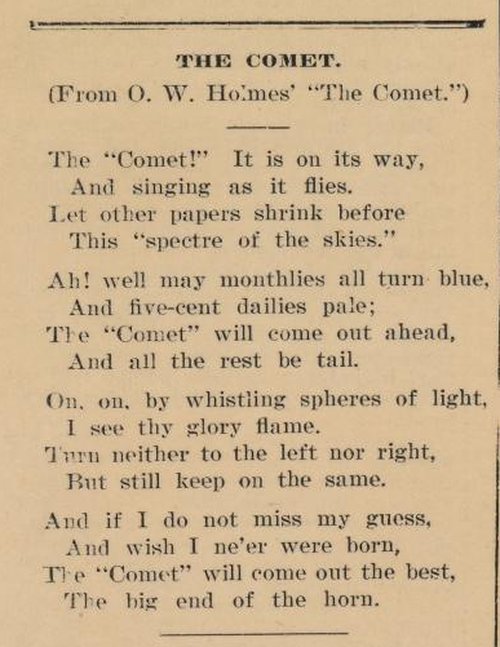The Comet
The Comet began as a student publication produced monthly during the school year.*******************************************
VIEW EARLIEST COMETS ONLINE The Brian W. Schenk Archive received the 2018 Rescuing Texas History grant to digitize a portion of our collection, to be included in the Portal to Texas History! We are thrilled to partner with the University of North Texas on this project! See digital copies of the earliest editions of The Comet here. ******************************************* |
We have a collection of the last 100 years of yearbooks available for viewing in the Archive, in the library.
|
By the late 19teens, publications were less frequent but contained more content, with editions coming out every 6 weeks for a time, then bi-annual editions for several years until it eventually became an annual in 1921. It was titled "The Violet Crown" that year.
Eventually, in 1928, a new monthly paper was established, The Maroon. This newspaper was well-written and contained many wonderful details of campus life. It was in publication for around 80 years before waning. For a time, The Maroon was mostly published online.
Currently, The Comet remains the primary student publication of the campus, with some tabloid editions of The Maroon released each year.
Why is it called "The Comet"?
|
Remarks from Sara (Wimberley) Stewart, AHS Librarian and alumna, class of 1997.
I've attempted to figure out why the publication bears the name, "The Comet." Here's what I have personally concluded: The second edition of The Comet (January 3, 1898) features a short parody of a poem from O. W. Holmes, also titled "The Comet." Holmes (1809-1894) was a physician, poet, and humorist. He wrote his poem "The Comet" in 1832 about the anticipated visit of Halley's Comet, which would be seen from Earth again in 1835. The full original poem describes Halley's Comet, the "spectre of the skies," with great celebration of its excellence and might. It seems likely that the students would have read the poem (I'll continue to look for evidence to support this notion) and made a connection to their desire for their school publication to have a similar reputation, one of grandiosity, an awe-inspiring work to outshine all others. The parody presents their paper, The Comet, as causing others to shrink before it, pale in comparison, and be less fortunate. The Comet would come out the big end of the horn, which is to say it would be successful and prosperous. |
In those early days, students exchanged their publications with other schools, across the state and country, which created an awareness of the events and values of other communities and served to keep the students challenged to do their best work. Much like today's social media comments, students would give evaluations of each publication, complimenting and critiquing. Commentary was featured in subsequent publications. Such "exchanges" served to raise the bar for all and ensured students published high quality work.
In the image below, on the left, are the students who published the very first edition in December of 1897: William Decatur Blackburn, Maud Galen Barton, William Lawrence Harrison, Fred McLaughlin, Mary Evelyn Copes, William Haven Moore, all members of the class of 1898. It's likely some or all of them are responsible for the selection of the name. The title was hand-written in red ink at the top of the first page of a 4-page paper, which had been hand typed and copied on a hand-cranked machine. Subsequent issues were printed by a publisher. They went on to publish a total of 5 editions in Volume 1, then many of the originators graduated, leaving The Comet in the hands of their peers. Several other students had joined them during the spring semester (image below on right).
What happened next is unclear. The second volume was not published until fall of 1902. It seems that four school years passed without The Comet. However, in the first edition of Volume 2 (Oct 1902), there is an editorial that references a June number (presumably June 1902?) and a Senior Society that had been responsible for The Comet until that time, but it was being transferred to a council with representatives from various groups in the school. So what about all the Comet editions from May 1898 to October 1902? Were they titled The Comet or something else? Why was October 1902 only the second volume if publication had continued since 1898? Did they simply continue numeration of the issues across multiple years? Are there copies of these papers out there, stuffed in boxes in attics, at the back of hall closets, or filed away in dusty old spaces or in antique stores? I hope so. If you come across anything, send them to us!
What happened next is unclear. The second volume was not published until fall of 1902. It seems that four school years passed without The Comet. However, in the first edition of Volume 2 (Oct 1902), there is an editorial that references a June number (presumably June 1902?) and a Senior Society that had been responsible for The Comet until that time, but it was being transferred to a council with representatives from various groups in the school. So what about all the Comet editions from May 1898 to October 1902? Were they titled The Comet or something else? Why was October 1902 only the second volume if publication had continued since 1898? Did they simply continue numeration of the issues across multiple years? Are there copies of these papers out there, stuffed in boxes in attics, at the back of hall closets, or filed away in dusty old spaces or in antique stores? I hope so. If you come across anything, send them to us!





